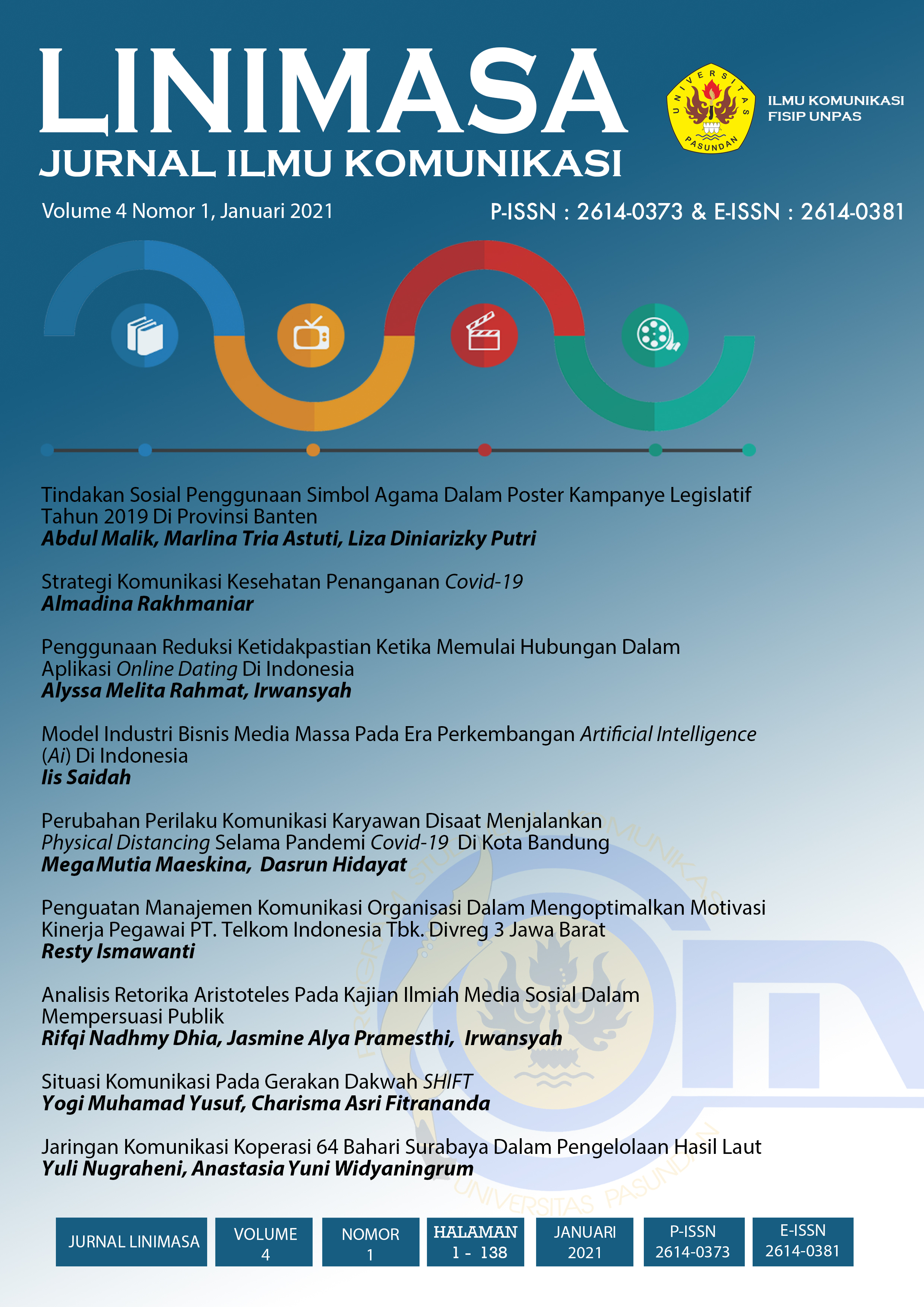ANALISIS RETORIKA ARISTOTELES PADA KAJIAN ILMIAH MEDIA SOSIAL DALAM MEMPERSUASI PUBLIK
DOI:
https://doi.org/10.23969/linimasa.v4i1.3530Keywords:
Aristotle’s rhetoric, Social media, YouTube, Public speaking, CommunicationAbstract
In order to build public awareness of the current crisis, many persuasive messages are disseminated through social media. Public communication is considered to be utilizing the power of YouTube as a popular social media platform in effectively communicating crisis through persuasive messages. In previous research the three aspects of ethos, pathos, and logos have been found as evidence of rhetoric in conveying persuasive messages made by YouTubers. The implications of study about rhetoric continue to develop today. This study aims to review other Aristotle’s rhetoric concepts that has not been analyzed in previous studies. The research used qualitative exploratory methods including in-depth interviews and observations. The sample size of participants in this study follows the concept of saturation. The study uncovered that there are two other concepts regarding rhetorical theory by Aristotle in this study — the type of rhetoric used and the five rhetorical canons when the speaker conveys a message. The researcher suggests further research to explore the concept of rhetorical inartistic evidence that is outside the rhetoric element brought by the speaker, so that the study can be discussed more comprehensively.
Downloads
References
Abidah, A., Hidaayatullaah, H. N., Simamora, R. M., Fehabutar, D., & Mutakinati, L. (2020). The Impact of Covid-19 to Indonesian Education and Its Relation to the Philosophy of “Merdeka Belajar.” Studies in Philosophy of Science and Education, 1(1), 38–49. https://doi.org/10.46627/sipose.v1i1.9
Adams, J., Khan, H. T. A., Raeside, R., & White, D. (2007). Research Methods for Graduate Business and Social Science Students. Vivek Mehra for Response Book. http://library1.nida.ac.th/termpaper6/sd/2554/19755.pdf
Alberico, J., & Loisa, R. (2019). Retorika Deliberatif Selebgram dalam Memotivasi Audiens Melalui Media Sosial (Konten “Level Up” di Akun Instagram Benakribo). Koneksi, 3(1), 236. https://doi.org/10.24912/kn.v3i1.6215
Atkins, J. (2018). “Strangers in their own Country”: Epideictic Rhetoric and Communal Definition in Enoch Powell’s “Rivers of Blood” Speech. The Political Quarterly, 89, 362–369.
Booth, W. C. (2004). The Rhetoric of Rhetoric: The Quest for Effective Communication. Blackwell Publishing. https://doi.org/10.2307/2709750
Charteris-Black, J. (2012). Forensic deliberations on ‘purposeful metaphor.’ Metaphor and the Social World, 2(1), 1–21. https://doi.org/10.1075/msw.2.1.01cha
Creswell, J. W., & Creswell, J. D. (2018). Research Design: Qualitative, Quantitative and Mixed Methods Approaches (5th Editio). Sage Publications.
Emanuel, B., Rodrigues, C., & Martins, M. (2015). Rhetoric of interaction: Analysis of Pathos. Lecture Notes in Computer Science (Including Subseries Lecture Notes in Artificial Intelligence and Lecture Notes in Bioinformatics), 9186, 417–427. https://doi.org/10.1007/978-3-319-20886-2_39
Faizin, B., Ramdhani, M. A., Gunawan, W., & Gojali, D. (2018). Speech Acts Analysis in Whatsapp Status Updates. 260(Icomacs), 189–191. https://doi.org/10.2991/icomacs-18.2018.46
Fernández, I. B., García, F. G., & Mas, J. S. V. (2013). Ethos, Pathos and Logos in Facebook. User Networking: New »Rhetor» of the 21th Century. Comunicar, 21(41), 127–136. https://doi.org/10.3916/C41-2013-12
Griffin, E., Ledbetter, A., & Sparks, G. (2018). A Firsh Look at Communication Theory (Tenth Edit). McGraw-Hill Education.
Khan, M. L. (2017). Social media engagement: What motivates user participation and consumption on YouTube? Computers in Human Behavior, 66, 236–247. https://doi.org/10.1016/j.chb.2016.09.024
Koetke, J., Schumann, K., & Porter, T. (2020). Trust in science increases conservative support for social distancing. https://doi.org/https://doi.org/10.31219/osf.io/cngq8
Littlejohn, S. W., Foss, K. A., & Oetzel, J. G. (2017). Theories of Human Communication. Eleventh Edition. In Waveland Press (Vol. 53, Issue 9).
Mason, M. (2010). Sample size and saturation in PhD studies using qualitative interviews. Forum Qualitative Sozialforschung, 11(3). https://doi.org/10.17169/fqs-11.3.1428
McMullan, J. (2020). A new understanding of ‘New Media’: Online platforms as digital mediums. Convergence, 26(2), 287–301. https://doi.org/10.1177/1354856517738159
Morse, J. M. (1991). Approaches to Qualitative-Quantitative Methodological Triangulation. In Nurs Res (Vol. 40, Issue 2, pp. 120–123).
Phillips, K. R. (2019). Proofs of the Past: Rhetorical Approaches to Difficult Memories. RÉTOR, 9(2), 139–152.
Rohlinger, D. A. (2019). New Media and Society. New York University Press.
Romadhan, M. I. (2018). Tren’s Personal Branding Youtuber Indonesia. Linimasa: Jurnal Ilmu Komunikasi, 1(2), 33. https://doi.org/10.23969/linimasa.v1i2.1080
Samuel-Azran, T., Yarchi, M., & Wolfsfeld, G. (2015). Aristotelian rhetoric and Facebook success in Israel’s 2013 election campaign. Online Information Review, 39(2), 149–162. https://doi.org/10.1108/OIR-11-2014-0279
Sofian, F. A. (2020). YouTubers creativity in creating public awareness of COVID-19 in Indonesia: A youtube content analysis. Proceedings of 2020 International Conference on Information Management and Technology, ICIMTech 2020, August, 881–886. https://doi.org/10.1109/ICIMTech50083.2020.9211149
Stebbins, R. A. (2011). What is Exploration. In Exploratory Research in the Social Science. Sage Publications.
Suswanto, P., & Setiawati, S. D. (2020). Strategi Komunikasi Pemasaran Shopee Dalam Membangun Positioning Di Tengah Pandemi Covid-19 Di Indonesia. Linimasa: Jurnal Ilmu Komunikasi, 3(2), 16–29. http://52.221.78.156/index.php/linimasa/article/view/2754
Sutrisno, I., Dan, & Wiendijarti, I. (2014). Kajian Retorika Untuk Pengembangan Pengetahuan dan Ketrampilan Berpidato. Jurnal Ilmu Komunikasi, 12(1), 70–84.
Thunström, L., Newbold, S. C., Finnoff, D., Ashworth, M., & Shogren, J. F. (2020). The Benefits and Costs of Using Social Distancing to Flatten the Curve for COVID-19. Journal of Benefit-Cost Analysis, 11(2), 179–195. https://doi.org/10.1017/bca.2020.12
Tracy, S. J. (2020). Qualitative Research Methods: Collecting Evidence, Crafting Analysis, Communicating Impact. John Wiley and Sons, Inc. http://library1.nida.ac.th/termpaper6/sd/2554/19755.pdf
Venus, A., Pratama, A., Sugiana, D., & Noor, F. (2019). Rhetoric Analysis Tolerance and Intolerance Post in Social Media. International Journal of Multicultural and Multireligious Understanding.
Wahdian, & Setiawati, S. D. (2020). Customer Relationship Management Pt. Samsung Electronics Indonesia Di Tengah Pandemi Covid-19 Di Indonesia. Linimasa: Jurnal Ilmu Komunikasi, 3(2), 55–66. http://www.journal.unpas.ac.id/index.php/linimasa/article/view/2778
Weill, J. A., Stigler, M., Deschenes, O., & Springborn, M. R. (2020). Social distancing responses to COVID-19 emergency declarations strongly differentiated by income. Proceedings of the National Academy of Sciences of the United States of America, 117(33), 19658–19660. https://doi.org/10.1073/PNAS.2009412117
West, R., & Turner, L. H. (2010). Introducing Communication Theory: Analysis and Application. Mc-Graw- Hill.
Westwick, J., & Chromey, K. (2014). Exploring the Canons of Rhetoric through Phil Davison’s Campaign Stump Speech. Discourse: The Journal of the SCASD, 1(1), 12.
Widiastuti, T. (2017). Forming the Personal Branding of Sandiaga Uno As a Public Leader in 2017 on Rhetoric Perspective. Journal Communication Spectrum, 7(1), 74–89. https://doi.org/10.36782/jcs.v7i1.1783
Xu, W. W., Park, J. Y., Kim, J. Y., & Park, H. W. (2016). Networked Cultural Diffusion and Creation on YouTube: An Analysis of YouTube Memes. Journal of Broadcasting and Electronic Media, 60(1), 104–122. https://doi.org/10.1080/08838151.2015.1127241















